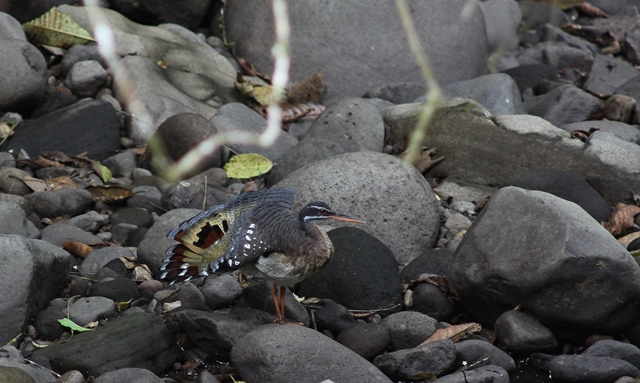Although I have helped people informally here locally many times to find and photograph birds, this week brought my first professional experience as a bird guide. Working through Serendipity Adventures (http://www.serendipityadventures.com/aboutSerendipityCostaRica/contactUs.htm), located here in San Antonio, I spent the best part of three days with Kim and Sam, from Minnesota and Louisiana respectively, looking at birds down on the CATIE campus in Turrialba, at the Rancho Naturalista in Tuis (including the nearby La Mina location, but not the famous Rio Tuis valley), and finally at the Guayabo National Monument, a few kilometers from here.
The weather cooperated by not raining and also by giving cloud cover most of the time. This gives better conditions for birding since bright, hot sun keeps many birds hidden in the middle of the day. Our bird totals were far from impressive, with around only 50 to 65 species per day, but most species were new to Kim and Sam and they enjoyed getting a good look at unfamiliar species and taking photographs. We were restricted as to habitat because the eruption of the Turrialba Volcano prevented access to highland species on the volcano road, but we missed many common species and failed to record any rarities, even though Cerulean Warbler and Ashy-throated Chlorospingus were right there at Rancho Naturalista. We missed them because we bumped into a combination of large ants on the path that you had to run through, a large but friendly Quebecois birding party, and the appointed hour for lunch. My thanks to Kathy and John for the lovely meals and the lively conversation.
I found that you spend a surprisingly large amount of time in certain places and thus have to restrict the number of birding locations if the trip is not to be a complete rush. I tried to push in a couple of quick visits to spots where I knew I could perhaps find a certain bird (e.g. Emerald Toucanet), but we had to stick to timetable and so missed out.
Birding highlights for me were the Scale-crested Pygmy-Tyrant (Lophotriccus pileatus) (accolades to Karel Straatman for his beautiful file photo), which we found at Guayabo National Monument, and the beautiful male Snowcap (Microchera albocoronata) at the feeders at Rancho Naturalista. We found at least 8 different species of hummingbird there, with the White-necked Jacobin outnumbering all others, as it does at friend Wiet Wildeman’s feeders near to home in San Rafael.
Hummers for the day at Rancho Naturalista:
- White-necked Jacobin
- Green Hermit
- Green-breasted Mango
- Green Thorntail
- Violet Sabrewing
- Crowned Woodnymph
- Snowcap
- Rufous-tailed Hummingbird
A common bird in the forest at Rancho Naturalista is the Red-throated Ant-tanager (Habia fuscicauda), and we were treated to close-up views of both the male and the female. Here, again by courtesy of Karel Straatman, is a very nice picture of a male. I remember helping to band a similar male at CATIE a few years back. The olive-brown female is similar but with a yellow throat. Picture any one?
La Mina is located just after the small town of Platanillo and is definitely worth a visit. It consists chiefly of a path alongside a small river, but we found two pairs of Sunbitterns (Eurypiga helias) and a fifth solitary bird, without too much searching. Kim had a great time trying to get a picture of one displaying the startling sun pattern on the wings. Pretty little Torrent Tyrannulets (Serpophaga cinerea) were also present.
Our last day was spent almost entirely at Guayabo National Monument, and even though we missed the very early morning hours we had fairly constant activity at the picnic ground and inside on the main Monument trail. Only later, on the road leading up to Guayabo Arriba and Torito, did things tail off a bit. In addition to the Scale-crested Pygmy-tyrant we found many other flycatchers, with at least one eluding identification. Page 233 in the new edition of Garrigues and Dean’s The Birds of Costa Rica shows the problem species. I identified the Slaty-capped Flycatcher (Leptopogon superciliaris) fairly easily because of the dark ear patch, but a grey-headed, yellow-bodied bird could have been either the Yellow-olive or the Yellow-margined Flycatcher. We couldn’t catch the colour of the iris, but Sam has at least one photo that should arrive shortly and that may help clear up the matter. I am very uncertain of my previous sightings of the two aforementioned species. I have already written in detail on this matter, and I again appeal for help from birders with experience of the two species. Please see my earlier posts by entering the term Yellow-olive Flycatcher.
Details of sightings made on this trip at all three locations can be found at http://ebird.org/ebird/camerica/eBirdReports?cmd=subReport





It gives me great joy to read this post Mr. Pickering, and to have been a part of this first-time experience for you. I really had little doubt it would be a success for you, for Sam and Kim, and for Serendipity Adventures. Peace to you my friend, and may this be the beginning of a long-standing relationship.
LikeLiked by 1 person
Hi Alex, I hope you’ll be able to stop by for birds and beer!
LikeLike
Congratulations, Paul! It’s great when you can “work” doing what you love. Best wishes and hope you have more jobs in the future!
LikeLiked by 1 person
Hi Stephie, we hope to see you again here some time soon. Best wishes from Ches and me.
LikeLike
I thought of you when I saw the notices about the volcano that was blowing some steam! Glad to know all’s fine and you’re sharing your birding experience with others.
LikeLiked by 1 person